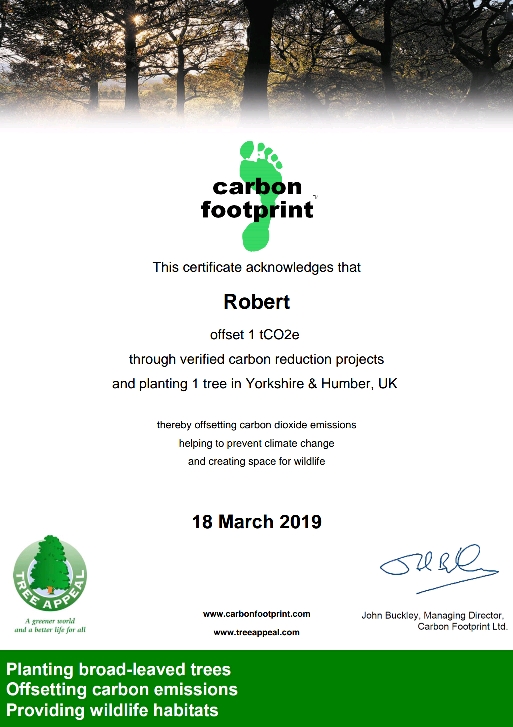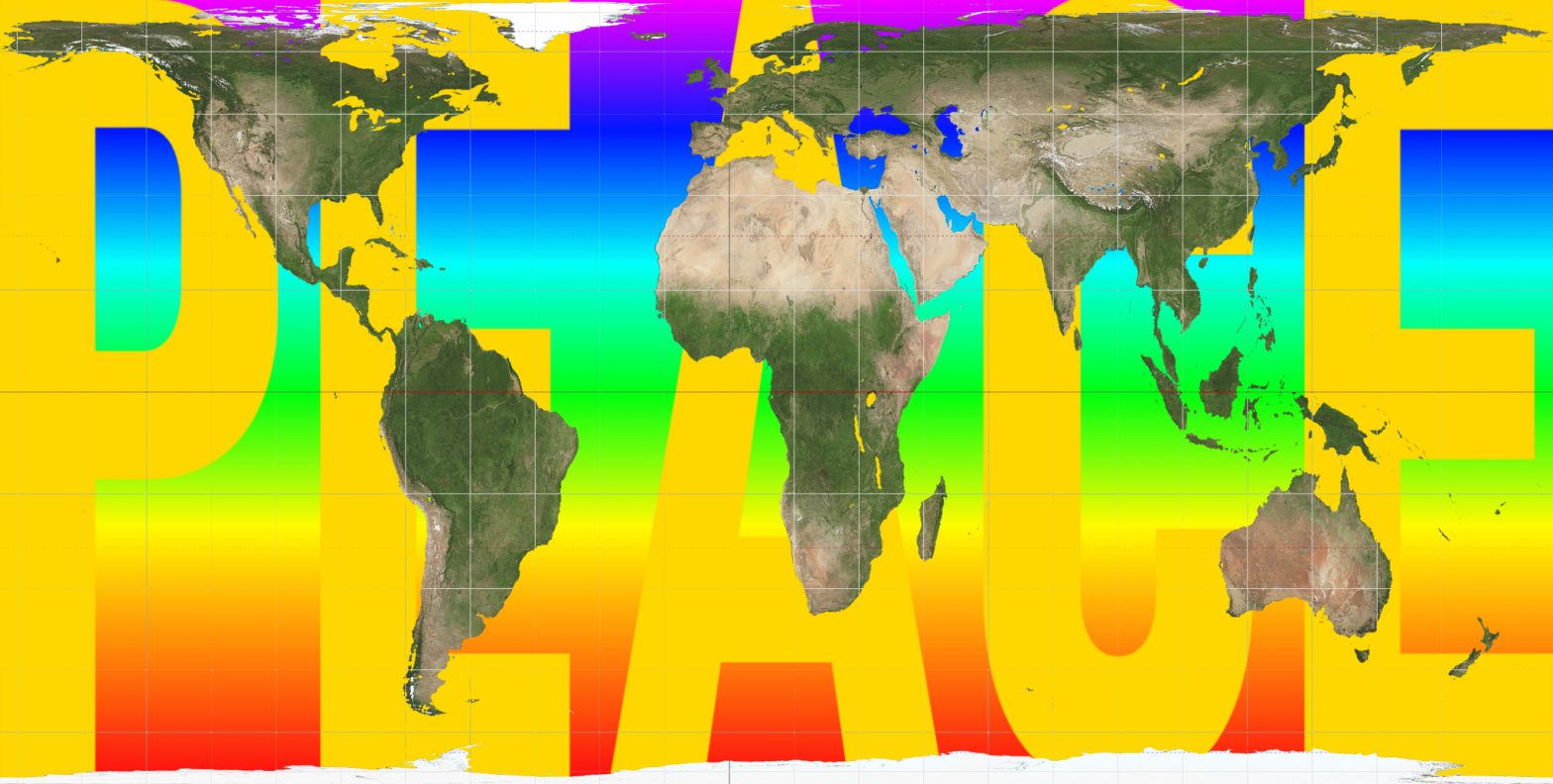On Monday 18th March 2019 I offset 1 metric tonne (1000 kg) of equivalent carbon dioxide (CO₂e) emissions by paying towards “verified carbon reduction projects and planting 1 tree in Yorkshire & Humber, UK”.

Carbon-offsetting in this way means that, in theory at least, the boat trips described below were carbon-neutral.
This is important because carbon dioxide is a greenhouse gas, which means that it traps heat from sunlight in the Earth’s atmosphere. A certain amount of greenhouse gases is essential for life on Earth, but too much of them can lead to an increase in the average temperature of the Earth’s atmosphere, due to the increase in trapped heat from the sun.
The Earth’s climate goes through natural cycles and changes over timespans of thousands of years or more, but when human beings unnaturally add excess greenhouse gases into the atmosphere by burning fossil fuels in large amounts, the result is an unnatural change in the Earth’s environment that is too quick to allow for plants and animals to naturally adapt.
However, if something is carbon-neutral, like these boat trips, then the extra greenhouse gases from the burning of a fossil fuel (in this case, the diesel used to power the boat) is countered and balanced by carbon reduction projects such as planting new forests and growing useful plants like hemp, as these absorb and store carbon.
In the long-term, it is better to not use fossil fuels in the first place, but instead to use renewable energy sources such as solar, wind, tidal, hydro and geothermal.
I believe that now, more than ever, it is important for the human race to learn to live in harmony with itself and with the planet Earth.
What does this 1 tonne of carbon off-setting cover?
According to data compiled by the VTT Technical Research Centre of Finland, a ferry going 24-27 knots creates equivalent carbon dioxide (CO₂e) emissions of approximately 0.4 kg of CO₂e per passenger per kilometre. For the sake of simplicity, I have assumed that every boat trip taken during this pilgrimage generates this amount of CO₂e per passenger per kilometre.
The ferry trip of Robert and Luke from Kingston upon Hull to Europoort, Rotterdam covered a distance of approximately 361 km (Days 49 & 50):
0.4 kg/km/person x 361 km x 2 people = 288.8 kg of CO₂e
The short car ferry trip from Rozenburg to Maassluis was approximately 0.57 km (Day 50):
0.4 kg/km/person x 0.57 km x 2 people = 0.456 kg of CO₂e
The boat tour of Rotterdam port was approximately 18.5 km (Day 52):
0.4 kg/km/person x 18.5 km x 2 people = 14.8 kg of CO₂e
The ferry trip of Luke from Europoort back to Kingston upon Hull (Days 53 & 54):
0.4 kg/km/person x 361 km x 1 person = 144.4 kg of CO₂e
The waterbus trip across Oude Maas from Zwijndrecht, Veerplein to Dordrecht, Hooikade was approximately 0.305 km (Day 55):
0.4 kg/km/person x 0.305 km x 1 person = 0.122 kg of CO₂e
The car ferry journey from Dordrecht, Kop van ‘t Land to Werkendam, Brabantse Oever was approximately 0.585 km (Day 57):
0.4 kg/km/person x 0.585 km x 1 person = 0.234 kg of CO₂e
The hour-long boat trip on the Rhine around Köln [Cologne] was approximately 22 km (Day 91):
0.4 kg/km/person x 22 km x 2 people = 17.6 kg of CO₂e
The boat trip from Köln to Bonn was approximately 33.5 km (Day 94):
0.4 kg/km/person x 33.5 km x 1 person = 13.4 kg of CO₂e
The boat trip from Bonn to Linz am Rhein was approximately 25 km (Day 95):
0.4 kg/km/person x 25 km x 1 person = 10 kg of CO₂e
The car ferry across the Rhein [Rhine] river from Bad Hönningen to Bad Breisig was approximately 301 metres (Day 98):
0.4 kg/km/person x 0.301 km x 1 person = 0.1204 kg of CO₂e
The short river crossings by boat in Koblenz were a combined total of around 582 metres (Day 106):
0.4 kg/km/person x 0.582 km x 1 person = 0.2328 kg of CO₂e
The river crossing in Koblenz (approx. 0.291 km), the boat trip from Koblenz to Bacharach (approx. 48.255 km) and the boat trip from Bacharach to Mainz (approx. 44.717 km) come to a combined total of approximately 93.263 km (Day 107):
0.4 kg/km/person x 93.263 km x 1 person = 37.3052 kg of CO₂e
The boat trip from Frankfurt am Main to Seligenstadt was approximately 34.5 km (Day 118):
0.4 kg/km/person x 34.5 km x 1 person = 13.8 kg of CO₂e
The boat trip from Riedenburg to Kelheim, and the return boat trip from Kelheim to Kloster Weltenburg, covered approximately 24.545 km (Day 192):
0.4 kg/km/person x 24.545 km x 1 person = 9.818 kg of CO₂e
The boat trips taken by Claire and Robert from Kelheim to Prunn, then Prunn to Essing and finally Essing to Kelheim, covered approximately 23.238 km (Day 195):
0.4 kg/km/person x 23.238 km x 2 people = 18.5904 kg of CO₂e
The boat trip from Regensburg to Bach was approximately 17.442 km (Day 199):
0.4 kg/km/person x 17.442 km x 1 person = 6.9768 kg of CO₂e
The boat trip from Deggendorf to Passau was approximately 59½ km (Day 206):
0.4 kg/km/person x 59.5 km x 1 person = 23.8 kg of CO₂e
The boat trip from Passau to Linz was approximately 91½ km (Day 207):
0.4 kg/km/person x 91.5 km x 1 person = 36.6 kg of CO₂e
The boat trip from Melk to Dürnstein was approximately 27½ km (Day 237):
0.4 kg/km/person x 27.5 km x 1 person = 11 kg of CO₂e
The boat trip from Dürnstein to Krems an der Donau was approximately 6½ km (Day 238):
0.4 kg/km/person x 6.5 km x 1 person = 2.6 kg of CO₂e
The boat trips from Krems an der Donau to Spitz and from Spitz to Wien [Vienna] totalled approximately 100 km (Day 240):
0.4 kg/km/person x 100 km x 1 person = 40 kg of CO₂e
The boat trip from Wien [Vienna] to Bratislava was approximately 57 km (Day 243):
0.4 kg/km/person x 57 km x 1 person = 22.8 kg of CO₂e
Total emissions in above calculations: approximately 714.3 kg of CO₂e.
Total emissions offset: 1000 kg of CO₂e.
See also: the Memorial Intermission Transport Carbon-Offsetting page.
